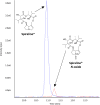HPLC-MS detection of pyrrolizidine alkaloids and their N- oxides in herbarium specimens dating back to the 1850s
- PMID: 30131885
- PMCID: PMC5947603
- DOI: 10.1002/aps3.1143
HPLC-MS detection of pyrrolizidine alkaloids and their N- oxides in herbarium specimens dating back to the 1850s
Abstract
Premise of the study: Understanding the phylogenetic distribution of defensive plant secondary metabolites is essential to the macroevolutionary study of chemically mediated plant-animal interactions. The chemical ecology of pyrrolizidine alkaloids (PAs) has been extensively studied in a number of plant-herbivore systems, including Apocynaceae (the milkweed and dogbane family) and Danainae (the milkweed and clearwing butterflies). A systematic survey is necessary to establish a detailed understanding of their occurrence across Apocynaceae. A survey of this species-rich, mainly tropical and subtropical family will rely heavily on small tissue samples removed from herbarium specimens, some of which will be very old and/or preserved with alcohols or mercuric chloride.
Methods: We optimized PA extraction methods from small leaf fragments of recently collected silica-dried leaves of the PA-positive Echites umbellatus, varying crushing and extraction time. We then applied our optimized method to leaf fragments from 70-167-year-old herbarium specimens of E. umbellatus. To simulate the effect of alcohol treatment on PA detectability in herbarium specimens, we incubated freshly collected leaves of the PA-positive Parsonsia alboflavescens in three different alcohols before drying and compared PA recovery to freshly dried controls. PAs were quantified using high-performance liquid chromatography-mass spectrometry analysis. X-ray fluorescence was used to identify mercury-containing specimens.
Results: Fifteen seconds of leaf crushing followed by 24 h of extraction were optimal for PA free-base and N-oxide recovery. This method yielded ~50-fold greater PA recovery than prior methods. Half of the herbarium specimens (13 of 23), including the oldest, tested positive for PAs; leaf age did not correlate with success in PA extraction. Treatment of fresh leaves with alcohol before drying did not diminish PA recovery; mercury was observed in both PA-positive and PA-negative specimens.
Conclusions: PAs can be reliably detected in small tissue samples from herbarium specimens up to 167 years old, including specimens that had been treated with alcohol or mercury salts. The variability of PA presence among herbarium specimens of E. umbellatus indicates that multiple specimens will need to be tested before a particular species is determined to lack PAs.
Keywords: Apocynaceae; Danainae; HPLC‐MS; coevolution; pyrrolizidine alkaloids; secondary metabolism.
Figures



References
-
- Ackery, P. R. , and Vane‐Wright R. I.. 1984. Milkweed butterflies, their cladistics and biology: Being an account of the natural history of the Danainae, a subfamily of the Lepidoptera, Nymphalidae. British Museum (Natural History), London, United Kingdom.
-
- Agrawal, A. A. , Petschenka G., Bingham R. A., Weber M. G., and Rasmann S.. 2012. Toxic cardenolides: Chemical ecology and coevolution of specialized plant–herbivore interactions. New Phytologist 194: 28–45. - PubMed
-
- Avula, B. , Sagi S., Wang Y., Wang M., and Khan I. A.. 2015. Pyrrolizidine alkaloids: Characterization in botanical and dietary supplements using accurate‐mass Q‐TOF LC/MS and all ions MS/MS. Agilent Application Note 5991‐6254EN. Agilent Technologies, Santa Clara, California, USA.
-
- Boppré, M. 1978. Chemical communication, plant relationships, and mimicry in the evolution of danaid butterflies. Entomologia Experimentalis et Applicata 24: 264–277.
-
- Boppré, M. 1984. Redefining “pharmacophagy.” Journal of Chemical Ecology 10: 1151–1154. - PubMed
LinkOut - more resources
Full Text Sources
Other Literature Sources
Research Materials

